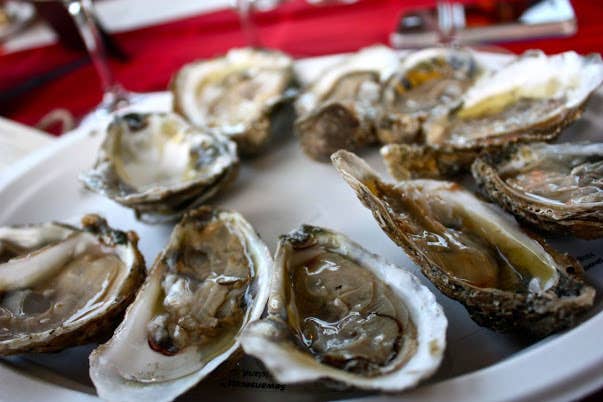
The Oyster Regions of Virginia
I met my first oyster when I was 12 and decided that we would never be friends. I was at a swanky seafood restaurant in Milan, Italy, with my meat-and-fish loving family who had been trying, unsuccessfully, to cure me of my staunch vegetarianism. I don't know why they thought oysters on the shell would do the trick, when much more appetizing-looking fare had failed. The one oyster (flown all the way from France, I was told) that was forcibly put on my plate looked raw, slimy, and highly suspect. I clung to my noble notions of vegetarianism and the oyster lived to see another plate.
Thankfully, judgments made on the brink of adolescence are seldom indubitable and last year, as part of a gradual process of abandoning vegetarianism, I patched up with the oyster. I ate my way through crowded oyster happy hours across Manhattan, starting with the usual—mild Hama Hamas with a touch of horseradish, briny Wellfleets with a squeeze of lemon and meaty Blue Points with a hint of cocktail sauce. How wrong I had been about oysters! They weren't slimy or suspect, they were soft and surprising, every oyster differing from the next—some brash with seawater, others delicate with mild sweetness, soft, chewy, sometimes earthy. While hunting for the different flavors of this delectable mollusk, I came across a heartening story of oyster resurrection in Virginia. Once a region that satisfied many oyster cravings among European royalty as well as affluent Americans of the late 19th century, the state saw decades of declining oyster populations due to overharvesting, disease and pollution. By the mid-1900s, Virginia oysters had entirely disappeared from our menus and tables.
Switch to present day, and Virginia is now once again a place that raises many happy oysters, thanks, in part, to a growing number of aquaculture oyster farms that can supply all year through (they grow triploid oysters which don't spawn in the summer and are grown solely for consumption). And even though these Virginian mollusks are of the same species as all other east coast oysters, Crassostrea Virginica, they're distinctly different in taste, even amongst themselves—since degree of salinity, algae content and other qualities of the water they grow in greatly modify the flavor of these bivalves. So much so, they're divided into seven oyster regions, from the length of Virginia's Eastern Shore, into the Chesapeake Bay, coastal rivers and down to the Lynnhaven Inlet of Virginia Beach. They're all delicious enough to rival better-known varieties from Long Island to British Columbia—plump and pillowy meat, nestled in deep, brittle shells, with a burst of creamy buttery-ness as soon as you bite into them and a mildly sweet finish—the kind of oysters that make me so grateful I got over my adolescent aversion.
A Guide to the 7 Oyster Regions of Virginia
Region 1: Seaside
Raised on the Atlantic side of Virginia's eastern shore, the full flavored oysters from this region pack an extremely salty punch. But if you chew the firm meat long enough, the saltiness washes away to reveal a sweet buttery finish with that ocean-oyster flavor. The famous Chincoteague oysters fall within this region. Look for:Sewansecott, Shooting Point Salts, Misty Point, Broadwater Salts, Olde Salts, Indian Rock
__
Region 2 and 3: Bayside Eastern Shore
Grown in creeks and tidal waters in the bayside of Virginia's Eastern shore, these oysters are exposed to waters with relatively lower salinity. Since region 2 is further north and therefore away from Atlantic waters, oysters from there have a mild saltiness that melts into a distinctly sweet and buttery finish as you chew on the tender texture. Oysters from region 3 on the other hand balance the salty and the sweet perfectly, with just a hint of ocean tastes and a clean finish. Look for: Pungoteague creek (2), Nassawadox Salts (3), Henderson Bros. Oysters (3), Watch House Point (3)
__
Region 4: Upper Bay Western Shore
If the kind of oysters you like tends towards the less-briny variety (some might call it bland), then region 4 is for you. Fed by the Sweetwater of the Potomac River and its estuaries as well as the headwaters of the Rappahannock River, these oysters have only the slightest hint of saltiness and a slight sweetness. They're creamy and meaty enough though to be wonderful when fried. Look for:Bevans oysters, Fleets Island Oysters, Little Wicomico Oysters
__
Region 5: Middle Bay Western Shore
One of the most balanced and savory of all Virginia oysters, these have a sweet, buttery mineral rich taste with a medium saltiness and a crisp light finish. Look for: Rappahanock River Oysters, Parrot Island Oysters, Urbanna Creek
__
Region 6: Lower Bay Western Shore
Drawn from the waters of Mobjack Bay and York River mixed in with a healthy influx from the Atlantic, the oysters from this region are plump, briny, and sweet with a clean, crisp finish. Saltier than Region 5 but not as salty as the Atlantic oysters, these are the quintessential Chesapeake Bay oyster. Look for: York River Oysters, York River shell oysters, Stingray oysters, Goodwin Island oysters
__
Region 7: Tidewater
Once coveted around the world, served to presidents and royalty for their size, saltiness and gentle zing, the Lynnhaven oysters from this region are the most exciting part of Virginia's oyster comeback story. Very salty with a slightly sweet and smooth finish, they are most impressive for their large size. Look for: Lynnhaven Oysters
Keep Reading
Continue to Next Story










